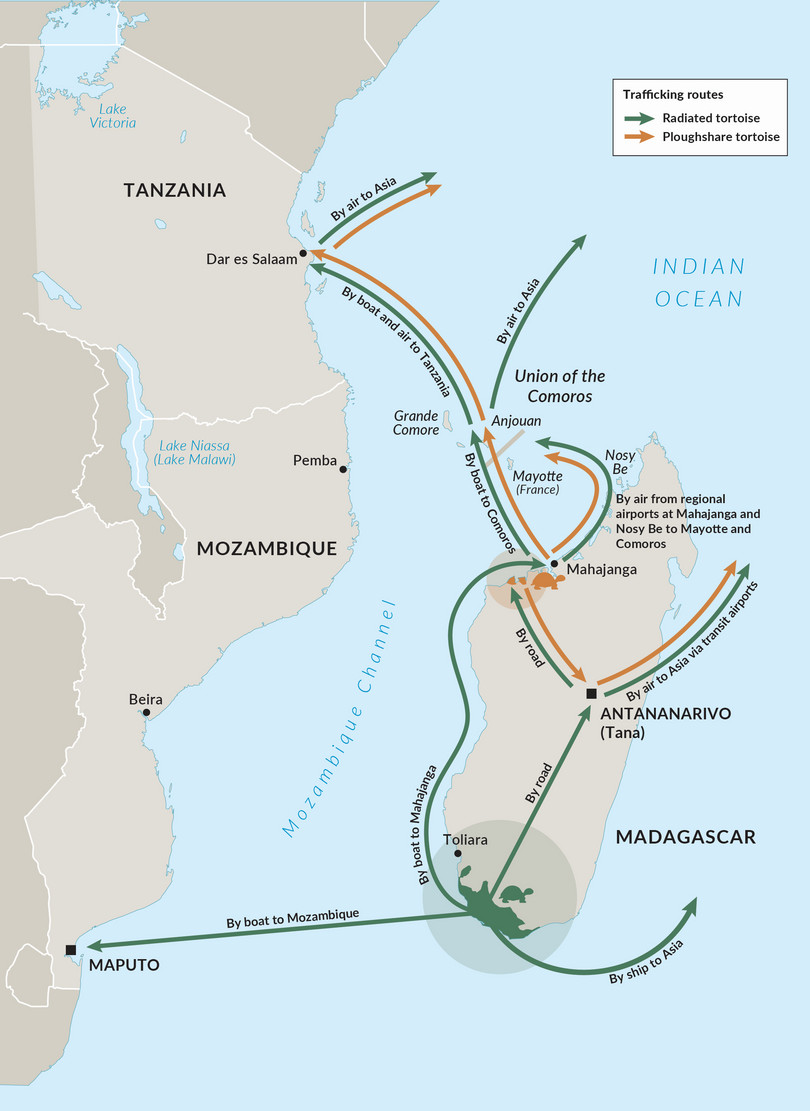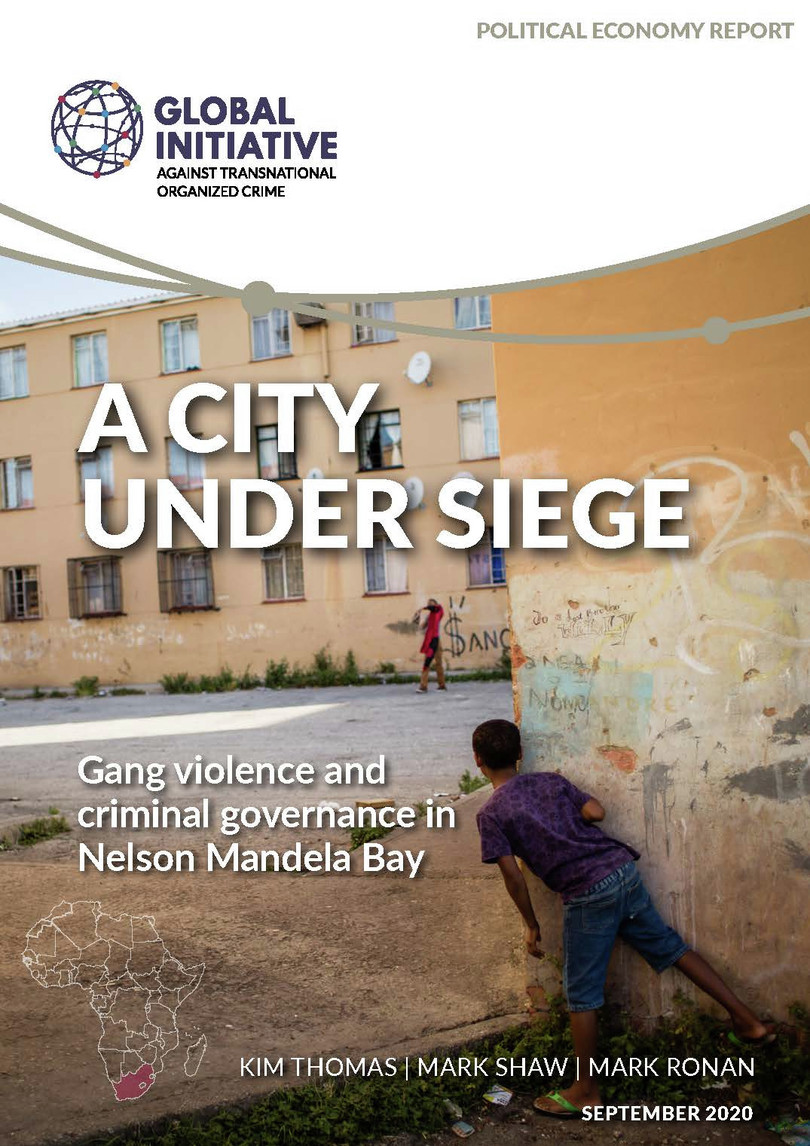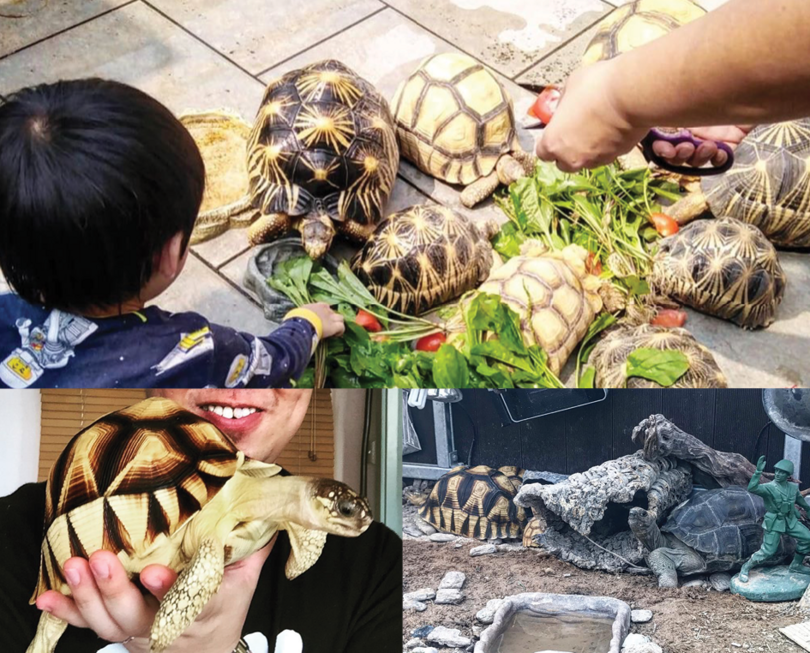Corruption, crime networks and social media: the international illicit trade in Madagascan tortoises.
In the struggle for the future of Madagascar’s critically-endangered ploughshare and radiated tortoises, decades of intense and successful conservation efforts have been nullified by huge increases in tortoise trafficking and poaching over the past 20 years. In the international exotic-pet trade, these tortoises’ very rarity is what drives smugglers’ interest. This is not just a conservation issue, but a governance issue: for every animal smuggled, there exists an extensive network of criminal and corrupt actors who actively and consistently undermine rule of law, governance and democracy.
Rising demand, diverse trafficking routes
In the 1980s and 1990s, demand was driven by specialist collectors from all over the world, but the Madagascan authorities did not pay much attention to reptile trafficking. This changed in 1996 with the theft of 75 ploughshare tortoises from the Ampijoroa breeding centre.1 This loss was followed by political changes a few years later: in 2004, the Malagasy government embraced biodiversity conservation and President Marc Ravalomanana spoke at the World Parks Congress in Durban, outlining a conservation plan that became known as the ‘Durban Vision’. This triggered investment in protected-area development and management, and efforts to tackle environmental crimes.2
Yet increasing demand from South East Asia, possibly driven by rising household income coupled with an interest in exotic pets, saw an increase in tortoise trafficking. Monitoring of trafficking trends have shown that trafficking has peaked around political instability in Madagascar, such as the coup that took place in 2009.3
Currently, tortoises are first trafficked by road from south-west Madagascar (radiated tortoises) or from the north-east (ploughshare tortoises). Although police inspection points on the main roads are ubiquitous (trafficked tortoises may pass through up to 20 checkpoints), there have been few reports of seizures at these checkpoints, suggesting that low-level corruption is rife.
The main tortoise-trafficking routes out of Madagascar are either by air from Ivato Airport in Antananarivo, or by boat from Mahajanga in the north-west to Comoros. Secondary routes include regional flights from smaller airports to Comoros, Mayotte or Réunion. More recently there have been reports of radiated tortoises going directly by ship from south-west Madagascar to China, or by fishing boat to Mozambique.
The use of Ivato Airport as the main exit point for tortoise trafficking from Madagascar raises particular concerns regarding corruption and security. The methods used are practiced and professional. Tortoises are shipped in suitcases both as personal luggage and freight. ‘Mules’ are sometimes offered US$500 to take a return flight to Bangkok with only hand baggage.4 Baggage check-in is facilitated by airport staff linked to the smugglers – there have been reports of bags bypassing security and being loaded directly onto the aircraft. At the destination, the passage of the mule and their luggage is again often facilitated by airport staff linked to the smugglers.5
Tortoise traffickers in Madagascar can be divided into two groups. The first comprises Malagasy citizens who collect tortoises and sell them to international traffickers. Into this category falls Andriamanalintseheno Tsilavina Ranaivoarivelo, alias Atsila Ratsila, an unemployed 27-year-old who had extensive contacts in South East Asia and was caught with radiated tortoises in a sting operation coordinated by conservation NGOs in Madagascar in 2016.6 Corruption is also a part of this group’s modus operandi. In one well-documented tortoise-trafficking investigation, Madagascan police officers reported that they had been immediately offered a US$6 800 bribe to release the Madagascan nationals they had placed under arrest, and there was subsequent pressure by a general to release the traffickers.7

Figure 5 Major trafficking routes of ploughshare and radiated tortoises, within Madagascar and across the region.
Source: Madagascar, ENACT Africa Organised Crime Index, https://ocindex.net/country/madagascar.
The second group comprises foreign nationals who are either based in Madagascar or who regularly travel there, such as Anson Wong, a notorious Malaysian wildlife trafficker whose operations in Madagascar were exposed in a documentary by Al Jazeera in 2013.8 Local sources currently describe a network of Asian nationals who have been living in Madagascar for a long time and run legal businesses, but who are known to also run a tortoise-trafficking operation.9 One researcher at an NGO, which specializes in investigating wildlife crime, described an Asian wildlife trafficker he is aware of who regularly travels to Madagascar and has contacts with corrupt senior police officers who facilitate his visits.10
Previous and ongoing GI-TOC research11 has identified various illicit flows that overlap with the same routes used by tortoise traffickers: cannabis and radiated tortoises travel by the same roads and through the same checkpoints from the south-west to Antananarivo;12 tortoises and heroin are both trafficked through airports; and tortoises, cannabis and illegal migrants are smuggled by boat to Comoros. There is little to suggest, however, that the same criminal networks are in control of the illegal tortoise trade and these other illegal markets: these have different drivers and different destination markets. But where these illegal flows are passing through the same routes and transport hubs, it is likely that they share the same facilitators who arrange transport and pay bribes to corrupt officials. The confluence of illicit flows is not coincidental. The erosion of governance and oversight associated with one illegal trade facilitates others.
Significant seizures of radiated and ploughshare tortoises (2017–2020)
The illicit market for tortoises
Thailand, Hong Kong and Indonesia are the most common final destinations for ploughshare tortoises.13 The animals are most commonly seized transiting Kenya, but were also seized transiting Mauritius, Comoros, the UAE and India. For radiated tortoises, China is the primary destination and Malaysia the second-most common destination – typically in flights leaving from Madagascar. Field data reported by the United Nations Office on Drugs and Crime in 2020 found that between US$2 and US$10 is paid per tortoise in Madagascar, and they are finally sold to customers for between US$1 000 and US$2 000 (for a one- to three-year-old animal, depending on the colour).14
Social-media sites and other online platforms play a crucial role in connecting players in the illegal tortoise market.15 Platforms such as Facebook, Instagram and others both facilitate and drive the exotic-pet market, firstly by providing a relatively traceless channel for sellers and buyers to connect, and secondly by popularizing – and through that, contributing to legitimizing – ownership of these species as pets.
As part of our research into the trade in Malagasy tortoises, we used an innovative machine-learning-powered tool called the Cascade to explore the potential for such tools in combatting the illegal trafficking of radiated and ploughshare tortoises. The tool has assisted in finding examples of endangered Malagasy tortoises being posted online, either by collectors showing of their specimens, sellers advertising their wares or the online back-and-forth where collectors and other enthusiasts discuss wildlife trading.
A broad response needed
The excellent species-conservation work being done by organizations on the ground to protect breeding populations, along with habitat-conservation initiatives in the key national parks, are helping to alleviate the dire situation for Madagascar’s tortoises.
Meanwhile, tortoise poaching and trafficking highlights larger governance and rule-of-law challenges in Madagascar. Addressing these problems is not a conservation issue. These are broader problems requiring broader responses focused on improving governance, rule of law and crime prevention and building resilience to organized crime – issues that fall within the remit of government agencies, rather than conservation NGOs.

This report draws from research in a recently published GI-TOC ESA – Obs research report, Trafficking in Malagasy Tortoises: Vulnerabilities and illicit markets in the western Indian Ocean by Alastair Nelson and Jaqueline Cochrane, which investigates the political economy of the illicit tortoise trade. This is part of several GI-TOC research projects looking at organized-crime dynamics in Madagascar, along the Swahili Coast and across the Indian Ocean islands. This research was discussed at an online seminar, Une plaque tournante: Madagascar’s changing role in regional illicit markets, which took place on 7 December 2020 and is now available as a recording. For more details, visit: https://globalinitiative.net/analysis/un-plaque-tournante-madagascar-webinar/.
Notes
-
Donald G. MacNeil, Madagascar reptile theft hits rarest of tortoises, New York Times, 2 July 1996, https://www.nytimes.com/1996/07/02/science/madagascar-reptile-theft-hits-rarest-of-tortoises.html. ↩
-
Malika Virah-Sawmy, The Durban vision in practice, in Conservation and Environmental Management in Madagascar, March 2014,
https://www.researchgate.net/publication/261178065_The_Durban_Vision_in_practice_experiences_in_participatory_governance_of_Madagascar%27s_new_protected_areas. ↩ -
Angelo R. Mandimbihasina et al., The illegal pet trade is driving Madagascar’s ploughshare tortoise to extinction, Oryx, 54, 2, https://www.cambridge.org/core/journals/oryx/article/illegal-pet-trade-is-driving-madagascars-ploughshare-tortoise-to-extinction/C1DA78BBC0307B96B1C3A75C723BA54E. World Bank, Madagascar: Measuring the impact of the political crisis, 5 June 2013, https://www.worldbank.org/en/news/feature/2013/06/05/madagascar-measuring-the-impact-of-the-political-crisis. ↩
-
Interview with Richard Lewis, Durrell Wildlife Conservation Trust, Antananarivo, 25 June 2020, Zoom call. ↩
-
TRAFFIC, unpublished internal report based on seizure and trade data for Malagasy tortoises for the period January 2008 to October 2016; interview with Kanitha Krishnasamy, TRAFFIC Director for South East Asia, 2 July 2020, Zoom call. ↩
-
Rowan Moore Gerety, In pursuit of the tortoise traffickers, The Guardian, 2 February 2018, https://www.theguardian.com/news/2018/feb/02/in-pursuit-of-the-tortoise-smugglers-madagascar-trafficking-endangered-species. ↩
-
USFWS, 7 African Wildlife Trafficking Bust Stories from 2016, USFWS International Affairs – Wildlife Trafficking, https://www.fws.gov/international/wildlife-trafficking/EAGLE-Week-Recap.html. ↩
-
101 East, Return of the Lizard King, Al Jazeera, 21 April 2015, https://www.aljazeera.com/programmes/101east/2013/11/return-lizard-king-2013111683648328719.html. ↩
-
Interview with local source, Antananarivo, July 2020. ↩
-
Interview with international investigator, July 2020. ↩
-
Alastair Nelson, A triangle of vulnerability: Changing patterns of illicit trafficking off the Swahili coast, Global Initiative Against Transnational Organized Crime, 15 June 2020, https://globalinitiative.net/triangle-vulnerability-swahili-coast/. ↩
-
Global Initiative Against Transnational Organized Crime, Cannabis trafficking and endangered-tortoise trade drive corruption in Madagascar, Risk Bulletin of Illicit Economies in Eastern and Southern Africa, Issue 11, August 2020, https://globalinitiative.net/esaobs-risk-bulletin-11/. ↩
-
TRAFFIC, unpublished internal report based on seizure and trade data for Malagasy tortoises for the period January 2008 to October 2016; interview with Kanitha Krishnasamy, TRAFFIC Director for South East Asia, 2 July 2020, Zoom call. Convention on International Trade in Endangered Species of Wild Fauna and Flora, Tortoises and Freshwater Turtles (Testudines spp.), CoP17 Doc. 73, 24 September 2016, https://cites.org/sites/default/files/eng/cop/17/WorkingDocs/E-CoP17-73.pdf. ↩
-
United Nations Office on Drugs and Crime, World Wildlife Crime Report 2020, 10 July 2020, https://www.unodc.org/unodc/en/data-and-analysis/wildlife.html. ↩
-
Siv Rebekka Runhovde, Illegal online trade in reptiles from Madagascar, Global Initiative Against Transnational Organized Crime, September 2018, https://globalinitiative.net/wp-content/uploads/2018/09/TGIATOC-ReptileTrade-A4-Web.pdf. ↩

